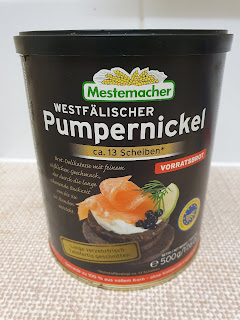There are certain tins that are fairly commonplace in kitchens pretty much everywhere - beans, tuna, tomatoes, chickpeas - your everyday tins; your "bread and butter" tins, if you will.
And then as this blog hopefully demonstrates, there are others which are far more unusual - your "bread" and "butter" tins, for example.
If that sounds a little confusing, it is deliberate - I was just trying to come up with an original way to start a blogpost about two unusual tins I'd tried - one of bread, and one of butter, both of which I had brought back from my travels some time ago. Bread! And butter! In tins! Crazy, I know. As soon as I saw them, I knew I couldn't return home without them.
There are various theories as to how the name "pumpernickel" originates; almost certainly untrue is the story that when invading Germany, the emperor Napoleon asked for bread and was served dark Westphalian rye. He declared it was only suitable for his horse, called Nickel (or Nicole) - "C'est du pain pour Nickel/Nicole!", he supposedly exclaimed.. More likely, and I think more enjoyable, is the idea that pumpern was a term in the old vernacular for being flatulent, and Nickel was a form of the name Nicholas, commonly associated with the devil or malevolent spirits in general, so pumpernickel hence means "farting devil" or "devil's fart". This could be a reference to the bread being hard to digest. Another idea is that the term was used, before it gave its name to the bread, in a pejorative sense for a person of unrefined manners (a "farting Nick"). The term was later adopted for the bread as it is made with unrefined rye.
Traditionally, the dark colour of pumpernickel comes not, as I has assumed, from any added ingredients like treacle or molasses, but from its very long, slow baking at a low temperature. The bread should also be made with an acidic sourdough starter, which destroys the rye protein (amylase) and converts starch to sugar. These days though, commercial bakers often use yeast and either citric or lactic acid in addition to the starter, or do away with the latter entirely.
My tinned version did have some malt extract and yeast in the mix, but I was pleased to see that it had the EU's Geschützte geografische Angabe (Protected Geographical Indication) quality kitemark on the label, which "emphasises the relationship between the specific geographic region and the name of the product where a particular quality, reputation or other characteristic is essentially attributable to its geographical origin." So at least some of the production, processing or preparation of this bread will have taken place in Westphalia, and the label does specifically mention its long, gentle 20-hour baking time. Whether or not any Westphalian "farting Nicks" were involved in the process cannot be said for certain though.
The cyclinder of bread wasn't as wide as the tin itself, so it rattled around a bit inside. It was ready-cut (Tafelfertig geschnitten) into 13 slices - unlucky for some, unless you're the person attempting to get nice thin slices with a very old breadknife. It had the lovely characteristically malty smell and sweet taste of rye bread, with just a very slight bitterness and acidic tang to it too. I had kept it well beyond the Best Before date, but despite being free of preservative (ohne Konservierungsstoffe) had kept very well in the tin, and continued to do so after opening, in the fridge with the plastic lid on top.
I was intrigued by the series of four photos on the label showing, I assume, different places or situations in which having a tin of long-life ready-sliced bread might be useful - a campervan, a boat, trekking up a mountain and, for some reason, a hot air balloon. I did not try any of these.
This delightful-looking tin from the Red Feather Brand actually hailed from New Zealand originally (a country renowned for its excellent butter) - but in fact I bought the tin in Mauritius of all places. So nice was the top of the tin, with the Red Feather logo between the words "Pure Creamery Butter", that I didn't want to damage it, and so opened it from the other (plain) end instead, to reveal a nice pale yellow butter. The texture however was weirdly grainy, and there was an oddly cheesy note to both taste and smell, a bit like the raw unpasteurised butter I had once bought on a whim from a farmer's market, though this was made with pasteurised cream. Slight cheesiness aside though, it had a nice flavour, slightly but not overly salty which I think is always the best way (you can always add a sprinkle more if you fancy it).
Back to the pumpernickel - I saved a couple of slices of that, as I had seen a recipe online that I really wanted to try - Yotam Ottolenghi's Pumpernickel Ice-Cream with Caramelised Crumbs (recipe available here on the Guardian website). Essentially it involves making a custard with cream that has been infused with crumbled pumpernickel. Then you melt some sugar, mix in more of the breadcrumbs, and spread onto greaseproof paper to cool into a sort of pumpernickel-crumb brittle. You then break that up and mix it into the custard half-way though the freezing.





















No comments:
Post a Comment